The Department of Water Affairs has announced that following the successful conclusion of the first phase of the Integrated Biological Remediation Programme at the Hartbeespoort Dam, it would be spending a further approximately R258.5 million on clean-up, rehabilitation and maintenance of the dam.
The Hartbeespoort Dam, situated in the North West province of South Africa, was originally designed for irrigation, which is currently its primary use. In a statement released by department spokesperson, Mava Scott, the department outlined that this amount was budgeted for the 2013/14 financial year and will be spent on operation and maintenance, fast tracking and full scale implementation and extension on the remediation programme for the once heavily polluted dam. “The department also intends to conduct an independent review on the programme as part of the requirement for further continuation. This review needs to be conducted within three months of approval to continue with Phase II, which began in September 2012. The procurement to appoint the Water Research Commission as the implementing agent to do the review is under way,” said Scott. The remediation of the dam started with the implementation of the Integrated Biological Remediation Programme (known as Harties Metsi a me) in 2008. This has led to significant improvement of the state of the dam and over- all quality of the water.In the 2011/12 financial year, expenditure on the remediation programme was R18.4 million. “At the moment, however, the department is engaged in procurement processes to appoint an implementing agent for the second phase of the programme to ensure a seamless continuation of the Hartbeespoort Dam Remediation Plan. The effectiveness of current interventions is reviewed on an ongoing basis and the implementation is overseen by the Hartbeespoort Dam Inter-governmental Steering Committee,” said Scott.
Scott added that through the programme 70 permanent workers were employed, more than 98 t of dead fish was removed from the dam litter, as well as debris and hyacinths. There has also been a significant improvement in the quality of the fish in the dam. He concluded that the department remains committed to the fight against pollution and “such efforts will go a long way in ensuring a more sustainable management of our water resources.”






